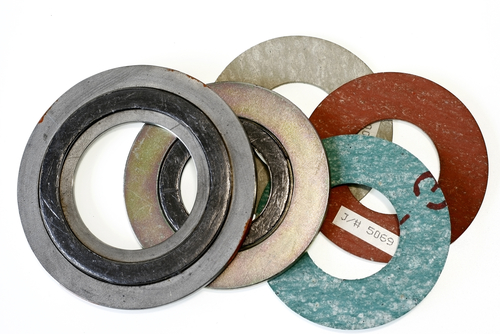There are numerous types of non-metallic gaskets commonly used in industrial sectors. Here are the classifications and applications of non-metallic gaskets, as well as some advantages and disadvantages of each.
Classifications of Non-Metallic Gaskets
Common types of non-metallic gaskets include:
- Fiber reinforced gaskets
- Graphite gaskets
- PTFE gaskets
- Rubber gaskets
Fiber Reinforced Gaskets
Fiber reinforced gaskets are either cut or punched to shape out fiber reinforced sheet material. These sheet materials are products usually consisting of fibers, fillers and binders. The quality and composition of these three components and the production process determine the gasket properties. NBR is most commonly used as a high quality binder for gasket materials. Because of outstanding technical properties aramide is the most essential fiber used in these type of non-asbesto gaskets.
Commonly Used Fibers in Fiber Reinforced Sheets
Aramide Fiber
Aramide fiber is an aromatic amide fiber which offers high strength and stability, with medium temperature suitability. Raw fibers can fibrillate.
Carbon Fiber
Carbon fibers contain thermal conductivity which ensures rapid heat dissipation and allows high temperature capability (except in oxidizing atmospheres). These fibers have a wide chemical resistance, and may be used in the pH range 0-14, although they must not be used in oxidizing environments.
Cellulose Fiber
Cellulose is a natural fiber, suitable for low temperature and medium pressure applications. Raw fibers can fibrillate.
Glass Fiber
Glass fibers are an inorganic complex of metal silicates, which offer good strength and moderate chemical resistance. These fibers are suitable for medium to high temperature applications. The fibers do not fibrillate.
Mineral Fiber
Mineral fiber, also referred to as “mineral wool, is an inorganic fiber consisting of metal silicates, with a wide range of diameters. This fiber is suitable for medium to high temperature applications. Fibers not fibrillate.
Advantages and Disadvantages of Fiber Reinforced Gaskets
Advantages of fiber reinforced gaskets include:
- Affordable and great availability
- Easy to cut/punch to size
A disadvantage of fiber reinforced gaskets includes:
- Limited in temperature resistance due to the rubber binder
Graphite Gaskets
With graphite gaskets, only graphite with a purity of > 99% elemental carbon can be used. Not only purity but composition of the ashes is extremely crucial for the performance of a graphite gasket. These gaskets are usually reinforced with stainless steel inserts. The design of the reinforcement is critical. Currently, smooth metal, tanged metal expanded metal inserts are common.
The distribution of surface pressure is optimized by expanded metal. The exceptional compression set of graphite allows excellent microsealing and adaptability. When replacing fiber reinforced gaskets by graphite gaskets, the gasket thickness can be reduced. Graphite has a superior chemical resistance against a wide range of media. It can be used in up to 450°-550°C application temperature. With expanded metal graphite gaskets, even metallic gaskets can be replaced in many applications.
Advantages and Disadvantages of Graphite Gaskets
Advantages of graphite gaskets include:
- Can easily follow any flange irregularity, Ra < 12,5
- No creeping
A Disadvantage of graphite gaskets includes:
- No resistance in oxidizing environments
PTFE Gaskets
PTFE gaskets provide a great chemical resistance. These gaskets are only attacked by molten alkali metals and fluorine gas. They also have excellent anti-stick and dielectric properties. Usually, the leak rates of PTFE gaskets are remarkably low and the only drawback of PTFE is creeping and poor mechanical properties.
Advantages and Disadvantages of PTFE Gaskets
Advantages of PTFE gaskets include:
- Very dense sealing material
- Adapts perfectly to the flange
- Extremely chemical resistant
Disadvantages of PTFE gaskets include:
- Limited temperature resistance
- Creeping
Rubber Gaskets
Rubber gaskets are cut or punched to shape from industrial manufactured rubber sheets made from industrial produced rubber. The following rubber compounds are available in sheets:
Acrylonitrile-butadiene Rubber
Acrylonitrile-butadiene rubber has improve chemical resistance and temperature capabilities to neoprene. It also has good resistance to hydrocarbons and oils. This type of rubber is not suitable for chlorinated hydrocarbons, esters, ketones and strong oxidizing agents. The temperature ranges from -30°-100°C.
Silicone
Silicone contains excellent temperature properties, and is unaffected by ozone and sunlight. This material is not suitable for many hydrocarbons and steam. The temperature ranges from -60°-200°C.
Chlorbutadiene Rubber
Chlorbutadiene rubber has excellent resistance to oils, ozone and weathering. It is suitable for moderate acids, alkalis, salt solutions, petroleum, solvents, oils and fuels. It is not recommended for strong acids or hydrocarbons. The temperature ranges from -45°-100°C.
Natural Rubber
Natural rubber is excellent for recovery properties. It also has good resistance to most inorganic salts, mild acids and alkalis. Oil and solvents, or where exposure to ozone, oxygen or sunlight is prominent is not recommended for natural rubber. Natural rubber consists of an elastomer which offers great resistance to ozone, oxygen or sunlight is prominent. The temperature ranges from -60°-80°C.
Ethylene Propylene Diene Rubber
Ethylene propylene diene rubber consists of an elastomer which offers great resistance to ozone, strong acids and alkalis. It is not suitable for solvents and aromatic hydrocarbons. The temperature ranges from -50°-150°C.
Butyl Rubber
Butyl rubber consists of an elastomer which offers great resistance to ozone and gas permeation. It is suitable for mild acids, alkalis and esters, but has little resistance to oils and fuels. The temperature ranges from -40°-150°C.
Styrene Butadiene Rubber
Styrene butadiene rubber is suitable for use with weak organic acids and moderate chemicals. However, it is not suitable for strong acids, most hydrocarbons or ozone. The temperature ranges from -50°-100°C.
Fluoro Elastomer
Fluoro elastomer is excellent for oils and greases, fuels and aliphatic as well as aromoatic hydrocarbons. Some fire retardent hydraulic liquids and synthetic aviation engine oils are also suitable. The temperature ranges from -20°-200°C.
For more information on non-metallic gaskets, don’t hesitate to contact us here at Bryan Hose and Gasket with the link below!

